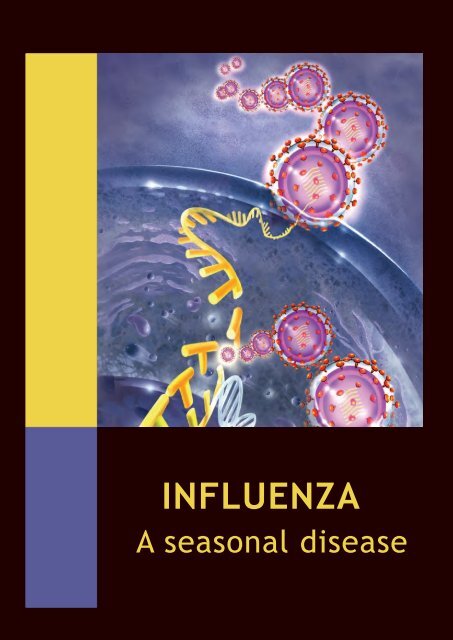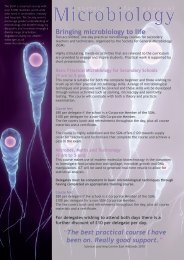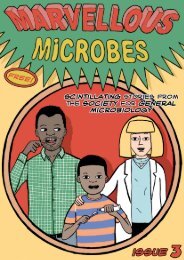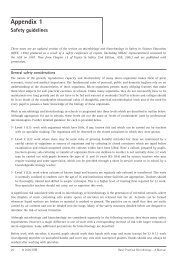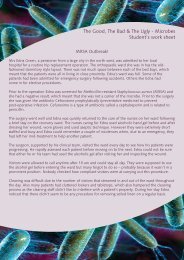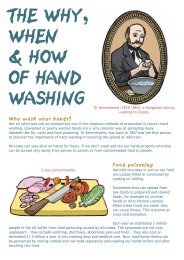INFLUENZA - Microbiology Online
INFLUENZA - Microbiology Online
INFLUENZA - Microbiology Online
You also want an ePaper? Increase the reach of your titles
YUMPU automatically turns print PDFs into web optimized ePapers that Google loves.
<strong>INFLUENZA</strong><br />
A seasonal disease
2 <strong>INFLUENZA</strong><br />
Influenza<br />
Influenza or flu is a common viral disease of the<br />
upper respiratory tract. There are three types<br />
of influenza virus: A, B and C. Major<br />
outbreaks of influenza are associated with<br />
influenza virus types A or B. Infection with<br />
type B influenza is usually milder than with type A.<br />
Influenza C is common but rarely causes disease.<br />
Influenza A is the most virulent type and is<br />
commonly associated with human disease.<br />
Between 1918 and 1919 flu is thought to have<br />
killed over 50 million people (6 times as many as<br />
died as a consequence of the World War I).<br />
This global pandemic possibly infected 50% of the<br />
world’s population and up to 20% died. It was<br />
caused by an unusually pathogenic strain of<br />
influenza A virus. Other global influenza<br />
pandemics have been recorded through history and<br />
they seem to occur every 10 to 40 years. Each year,<br />
many countries, including the UK, experience<br />
seasonal influenza epidemics that affect hundreds of<br />
thousands of people.<br />
Caricature of the H1N1 1918 flu pandemic<br />
What causes flu?<br />
The influenza virus particle - virion - is usually<br />
spherical in shape and carries its genetic material on<br />
eight pieces of single stranded RNA known as<br />
segments. Each segment carries genes that encode<br />
for proteins that the virus needs in order to<br />
replicate inside the infected host cell. The genome<br />
is protected by a membrane envelope. Protruding<br />
from the virus envelope are hundreds of copies<br />
of two different varieties of viral glycoprotein<br />
spikes. Approximately 80% of the spikes are<br />
haemagglutinin (HA) and the remaining 20%<br />
are neuraminidase (NA). The HA and NA surface<br />
proteins are involved in viral attachment and entry<br />
to host cells. They are also the main part of the<br />
virus recognized by our immune system as foreign,<br />
and most of the antibodies we make after infection<br />
are against these antigens.<br />
Computer artwork of an influenza virus particle split open to reveal the core<br />
of RNA genetic material. This is surrounded by a membrane envelope (yellow).<br />
In the envelope are two types of protein spike, haemagglutinin (H, blue) and<br />
neuraminidase (N, green), which determine the strain of virus.
<strong>INFLUENZA</strong><br />
3<br />
The stages of cell infection of an influenza virus. The virus appears rounded in shape, with a core of ribonucleic acid (RNA). It has a spiked outer coat which allows<br />
the virus to attach to host cells. Host cell cytoplasm appears granular. At top frames (3 images) the virus attaches to the cell, causing the cell membrane to fold around<br />
the virus. At lower frames (3 images) the virus penetrates the cell, infecting it, and causing more influenza viruses to be produced. This virus is contagious and invades<br />
mucus cells in the respiratory tract.<br />
Transmission<br />
The flu virus is extremely contagious and is<br />
transmitted from person to person by droplets<br />
expelled when sneezing and coughing. It can also<br />
be transmitted by direct contact, for example by<br />
touching virus-contaminated surfaces such as door<br />
handles and then touching the eyes or nose. Good<br />
hygiene practices, such as correct hand washing,<br />
are very important in preventing infection.<br />
Infection and replication<br />
Influenza viruses infect epithelial cells in the upper<br />
respiratory tract (nose and throat). If the infection is<br />
severe the virus can eventually reach the lungs and<br />
cause pneumonia. The respiratory tract’s first line<br />
of defence is a protective layer of mucus. The virus<br />
NA protein can cut through this enabling the virus<br />
particle to reach the epithelial cell surface. The virus<br />
then uses its HA protein to attach to a receptor on<br />
the host cell’s plasma membrane and is taken into<br />
the host cell by endocytosis. The ribonucleoprotein<br />
core, that contains the viral RNA and the viral<br />
polymerase used for replication, is released into<br />
the cytoplasm and moves into the nucleus. Viral<br />
RNA is replicated. The host cells’ own ribosomes<br />
are hijacked to make proteins from the viral<br />
mRNAs. New copies of the RNA genome are<br />
shuttled out of the nucleus and up to the plasma<br />
membrane where they combine with the newly<br />
made viral proteins and bud out of the cell’s plasma<br />
membrane, acquiring their envelope in the process.<br />
Finally, using the NA protein to cut themselves away<br />
from the infected cells, the new virions move away<br />
to infect other cells.<br />
The host cells are damaged when they become<br />
infected by the virus. The patient’s immune system<br />
responds by releasing chemicals called cytokines
4 <strong>INFLUENZA</strong><br />
which stimulate leukocytes (white blood cells) to<br />
travel to the site of infection and fight the virus.<br />
Most of the symptoms are in fact caused by the<br />
body’s immune response. These include:<br />
Woman suffering from flu<br />
high fever<br />
chills<br />
severe fatigue<br />
headaches<br />
muscular aches and pains<br />
non-productive cough<br />
sore throat<br />
When the NA protein of influenza breaks down<br />
the mucus lining the epithelial cells, this also<br />
leaves the cells more susceptible to infection by<br />
other pathogens, such as bacteria like Staphylococcus<br />
aureus and Haemophilus influenzae.<br />
The antiviral drug Tamiflu®<br />
Treatment<br />
Most people recover from flu within 1-2 weeks<br />
but more serious illness, and even death, can result<br />
from secondary infections e.g. bacterial pneumonia.<br />
This is more likely in infants, the elderly, people who<br />
are immunocompromised and those with chronic<br />
lung disease such as emphysema.<br />
There are two ways of tackling the disease:<br />
treating the symptoms and attacking the virus.<br />
The symptoms can be alleviated with drugs to<br />
reduce fever and pain such as paracetamol.<br />
Antiviral drugs can be effective against influenza<br />
but must be administered within the first 2 days<br />
of symptoms appearing. Drugs such as oseltamivir<br />
(Tamiflu®) attack the virus by inhibiting the enzyme<br />
neuraminidase and therefore prevent the virus from<br />
infecting cells.<br />
Antibiotics are not used to treat influenza<br />
because they work by inhibiting bacterial cell<br />
wall production and protein synthesis and block cell<br />
metabolism and have no effect on viruses. They can<br />
be used to treat secondary bacterial infections.
<strong>INFLUENZA</strong><br />
5<br />
Vaccines<br />
Antibodies that recognize the HA and NA surface<br />
proteins of the influenza virus can protect us from<br />
infection by stopping the virus reaching the host cell<br />
surface. This means that people will not be infected<br />
by the same strain of influenza after they recover<br />
from flu. Giving a small dose of a crippled strain of<br />
influenza virus or an injection of purified HA<br />
protein as a vaccine, can stimulate the immune<br />
system to make antibodies to HA to protect us<br />
from flu.<br />
Influenza vaccine<br />
Computer artwork of influenza vaccine manufacture in eggs.<br />
Fertilised chicken eggs can be used to produce vaccines against<br />
influenza viruses. The egg is inoculated with a mixture of the<br />
epidemic influenza virus strain (purple, top) and a standard<br />
strain (green) that can replicate in chicken eggs.<br />
Both strains replicate themselves, but as they do so their<br />
genetic material becomes mixed, producing hybrid viruses<br />
known as reassortants (purple, bottom). The reassortants are<br />
analysed, and those which have the epidemic strain surface<br />
proteins but other genes of the standard strain (shown in the<br />
yellow cone) will be selected. These are injected into different<br />
eggs to replicate before harvesting.
6 <strong>INFLUENZA</strong><br />
Cold or flu?<br />
The terms cold and flu are often used interchangeably but they are in fact distinct diseases caused by very<br />
different viruses. A cold is caused by several groups of viruses; the most common is rhinovirus and usually<br />
lasts between 2 and 4 days. Symptoms include runny nose, sneezing and mild fatigue. Flu is much more<br />
serious than a cold. Symptoms may last for a few weeks and the illness can be much more debilitating. If in<br />
doubt, remember the £50 test: if a £50 note is pinned to your front door and you are incapable of dragging<br />
yourself out of your sick bed to collect it…you have the flu. If the thought of free money puts a spring in your<br />
step…it’s just a cold!<br />
Flu epidemics and pandemics<br />
The influenza virus genes are made of RNA and are<br />
more prone to mutations than genes made of DNA.<br />
Influenza viruses undergo constant genetic variation.<br />
Antigenic drift<br />
Influenza viruses are changing by antigenic drift all<br />
the time. Mutations in the genes coding for the<br />
proteins NA and HA result in minor changes to<br />
surface proteins. If the HA antigen changes shape<br />
then the antibodies won’t be able to recognise it<br />
and bind to it. The newly mutated virus can then<br />
bind to receptors on the host cell and infect it.<br />
This is why it is possible for an individual to be<br />
infected more than once with influenza and why<br />
there is a global surveillance team that monitors the<br />
evolution of human influenza strains. Every year a<br />
new strain of virus emerges and the vaccine must<br />
be updated so that the antibodies it induces are a<br />
good match to the antigens of the strains that are<br />
circulating in the community.<br />
Antigenic shift<br />
This occurs in influenza A viruses only and is due<br />
to the reassortment of RNA segments from two<br />
different viral strains infecting the same cell<br />
producing viruses that have entirely new antigens.<br />
Wild birds get influenza infections all the time.<br />
Sometimes these avian viruses spread to chickens<br />
and cause outbreaks of ‘bird flu’ that can<br />
devastate poultry farms.<br />
Most bird flu viruses cannot infect humans. It is<br />
thought that most new strains of flu originate in<br />
China where many people live in crowded<br />
conditions, often in close contact with domesticated<br />
pigs and birds. Birds can transmit influenza to<br />
pigs. Pigs can transmit the virus to humans and vice<br />
versa. Recombination of human and bird strains<br />
inside pigs can result in novel strains of influenza A<br />
that will infect humans.<br />
With the increase in global transport and<br />
urbanization, epidemics caused by these new<br />
strains are likely to spread rapidly around the world.<br />
Theoretically these epidemics could be controlled<br />
by immunisation, but a new vaccine must be<br />
produced for each new strain of flu, so vaccines<br />
may not be immediately available in the threat of an<br />
epidemic. The World Health Organization (WHO)<br />
has developed a ‘global influenza preparedness<br />
plan’ which advises countries on how to prepare<br />
for the possibility of an pandemic. This involves:<br />
Rapid detection of unusual influenza<br />
outbreaks and isolation of possible<br />
pandemic viruses<br />
Measures to prevent spread of the<br />
disease, including: public health education,<br />
travel and trade restrictions and quarantine<br />
procedures<br />
Contingency plans for storage, distribution<br />
and safe administration of pandemic and<br />
routine influenza vaccine<br />
Provision to maintain adequate health<br />
care resources, including antiviral drugs,<br />
personnel and hospital resources
<strong>INFLUENZA</strong><br />
7<br />
Computer artwork showing two influenza viruses<br />
(pink and green) infecting a pig cell (pink sphere).<br />
The viruses use the host cell's machinery to<br />
reproduce copies of themselves. During this<br />
process the two genomes may be mixed and<br />
repackaged to form a new strain (purple). If<br />
the new strain is able to infect humans this<br />
introduces a new strain to which the population<br />
has no immunity to, giving it the potential to<br />
cause a pandemic.<br />
The unpredictability of pandemics!<br />
The WHO is on constant look out for the first signs of a pandemic. For some years there has been public<br />
concern that a strain of avian flu called influenza A H5N1 will mutate into a form that is easily transmitted<br />
between humans and cause a pandemic. The virus occurs in both wild and domesticated birds where it is<br />
transmitted in saliva, faeces and nasal secretions and has a high mortality rate. A small number of humans<br />
have contracted this strain of bird flu, mainly by close contact with poultry, and by July 2009 the WHO had<br />
confirmed 436 cases and 263 deaths worldwide. Currently there is very limited human to human<br />
transmission of the virus.<br />
In April 2009 scientists were surprised by the emergence of a novel influenza A H1N1 (2009) virus from<br />
Mexico. Popularly called ‘swine flu’, the strain contains a combination of genetic material that is typical to<br />
avian, swine and human flu viruses. It spread very rapidly around the world, causing 11,000 cases in<br />
42 countries in the first 4 weeks. On 11 June 2009 the WHO declared the first global flu pandemic for<br />
40 years. The pandemic was officially declared over in August 2010 although the strain continued to<br />
circulate.<br />
The H1N1 (2009) strain was included in the 2010/2011 seasonal flu vaccine along with two other<br />
influenza strains. The H1N1 (2009) virus is expected to continue to circulate as a seasonal influenza<br />
strain for the foreseeable future and because of this, more people will develop immunity to this current<br />
version of the virus. However, the virus is also expected to change over time, meaning that immunity to<br />
this current strain may not protect against future strains of the virus. Global influenza surveillance will<br />
continue to track the evolution of H1N1 (2009).<br />
Taking it further<br />
www.who.int/csr/disease/influenza/en/<br />
www.cdc.gov/flu/<br />
www.sgm.ac.uk/news/hot_topics/swineflu0609.pdf<br />
www.sgm.ac.uk/news/hot_topics/handhygiene.pdf<br />
www.hpa.org.uk
The Society for General <strong>Microbiology</strong> (SGM) is a professional body for scientists who work in all areas of<br />
microbiology. An important function of the Society is the promotion of the public understanding of microbiology.<br />
SGM produces and distributes a wide range of resources to support microbiology teaching in schools and colleges<br />
across all key stages and post -16. It also runs training courses in practical microbiology for teachers and technicians<br />
and occasional workshops. The Society also offers an information service to teachers and participates in schools<br />
competitions and other activities.<br />
School Membership of the SGM offers many benefits including:<br />
<strong>Microbiology</strong> Today, the award-winning magazine<br />
Discounts on SGM INSET courses<br />
Priority mailings of SGM teaching resources<br />
Contact<br />
SGM, Marlborough House, Basingstoke Road, Spencers Wood, Reading, RG7 1AG, UK<br />
T: 0118 988 1800<br />
F: 0118 988 5656<br />
E: education@sgm.ac.uk<br />
W: www.microbiologyonline.org.uk<br />
Infuenza - A seasonal disease<br />
Written by Gemma Sims and Dariel Burdass<br />
Designed by Dariel Burdass<br />
Edited by Janet Hurst<br />
Acknowledgements<br />
Thanks are due to Professor Wendy Barclay (Imperial College London) for her helpful comments on this<br />
text. Every care has been taken to ensure that the information is correct, but the author will be pleased to<br />
learn of any errors that have remained undetected.<br />
Picture credits<br />
Front cover, JIM DOWDALLS / SPL*, p.2 upper right, CCI ARCHIVES / SPL, p.2 lower left, THIERRY<br />
BERROD, MONA LISA PRODUCTION / SPL, p.3 top half, DR STEVE PATTERSON / SPL, p.4 upper right,<br />
Jupiter Unlimited, p.4 lower left, MARK THOMAS / SPL, p.5 upper right, DR P. MARAZZI / SPL, p.5 bottom<br />
half, RUSSELL KIGHTLEY / SPL.<br />
*SPL, Science Photo Library<br />
Copyright<br />
Influenza is copyright. The Society for General <strong>Microbiology</strong> asserts its moral right to be identified under<br />
Section 77 of the Design, Patents and Copyright Act, UK (1988).<br />
Educational use: Electronic or paper copies of the resources or individual pages from it may be made for<br />
classroom use and bona fide educational resources, provided that the copies are distributed free of charge<br />
or at the cost or reproduction and the SGM is credited and identified as copyright holder.<br />
© 2011 Society for General <strong>Microbiology</strong>y


